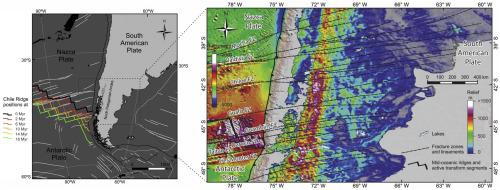当前位置:
X-MOL 学术
›
J. Geodyn.
›
论文详情
Our official English website, www.x-mol.net, welcomes your
feedback! (Note: you will need to create a separate account there.)
Tectonic segmentation across Patagonia controlled by the subduction of oceanic fracture zones
Journal of Geodynamics ( IF 2.1 ) Pub Date : 2021-01-01 , DOI: 10.1016/j.jog.2020.101806 Darío Leandro Orts , Orlando Álvarez , Claudia Zaffarana , Mario Gimenez , Francisco Ruiz , Andrés Folguera
Journal of Geodynamics ( IF 2.1 ) Pub Date : 2021-01-01 , DOI: 10.1016/j.jog.2020.101806 Darío Leandro Orts , Orlando Álvarez , Claudia Zaffarana , Mario Gimenez , Francisco Ruiz , Andrés Folguera

|
Abstract A set of fracture zones left by transform faults segmenting the active Chile Ridge that separates the Nazca and Antarctica Plates has been subducting beneath western Patagonia in the last 18 Myr. The subduction direction of these fractures zones has remained almost unaltered during this time lapse since these intersected the Chilean trench. In this context, the analyzed Patagonian sector is associated with the subduction of a highly buoyant oceanic floor due to its relatively young age that contrasts with the ocean floor bathymetry to the north where oceanic crust gets progressively older up to the Eocene and consequently isostatically subsides. Short-term elastic deformational patterns associated with the earthquake cycle have been linked to this segmentation imposed by subducting fracture zones in previous works. Similarly, this work explores the relationship between long-term topography, seismicity, gravity, and magnetic anomalies as a proxy for upper crustal structure, deformation, exhumation, and consequently surface geology segmented nature associated with this pattern of oceanic fracture zones. Through these analyses, we have identified a series of ENE structural trends or lineaments across the continental crust that could be directly related to the segmented mechanical behavior of the plate interface and enhanced by particular climatic and tectonic history of the Patagonian region. These evidences could contribute to the understanding of how fracture zones can control, to a certain extent, the segmented nature of the upper plate in a subduction setting.
中文翻译:

受大洋断裂带俯冲控制的巴塔哥尼亚构造分割
摘要 在过去的 18 Myr 中,分隔纳斯卡板块和南极洲板块的活动智利海脊的转换断层留下的一组断裂带一直在西巴塔哥尼亚下俯冲。自从这些断裂带与智利海沟相交以来,这些断裂带的俯冲方向在这段时间里几乎保持不变。在这种情况下,所分析的巴塔哥尼亚部分与高度浮力洋底的俯冲有关,因为它的年龄相对年轻,这与北部的洋底测深形成对比,在那里洋壳逐渐变老直到始新世,因此等静压下沉。与地震循环相关的短期弹性变形模式已与先前工作中俯冲断裂带强加的这种分割有关。相似地,这项工作探索了长期地形、地震活动、重力和磁异常之间的关系,作为上地壳结构、变形、折返以及与这种海洋断裂带模式相关的地表地质分割性质的代表。通过这些分析,我们确定了一系列跨大陆地壳的 ENE 结构趋势或线条,它们可能与板块界面的分段力学行为直接相关,并因巴塔哥尼亚地区的特定气候和构造历史而增强。这些证据可能有助于理解断裂带如何在一定程度上控制俯冲环境中上板块的分段性质。和磁异常作为上地壳结构、变形、折返以及因此与这种海洋断裂带模式相关的地表地质分割性质的代表。通过这些分析,我们确定了一系列跨大陆地壳的 ENE 结构趋势或线条,它们可能与板块界面的分段力学行为直接相关,并因巴塔哥尼亚地区的特定气候和构造历史而增强。这些证据可能有助于理解断裂带如何在一定程度上控制俯冲环境中上板块的分段性质。和磁异常作为上地壳结构、变形、折返以及因此与这种海洋断裂带模式相关的地表地质分割性质的代表。通过这些分析,我们确定了一系列跨大陆地壳的 ENE 结构趋势或线条,它们可能与板块界面的分段力学行为直接相关,并因巴塔哥尼亚地区的特定气候和构造历史而增强。这些证据可能有助于理解断裂带如何在一定程度上控制俯冲环境中上板块的分段性质。我们已经确定了一系列跨大陆地壳的 ENE 结构趋势或线条,它们可能与板块界面的分段力学行为直接相关,并因巴塔哥尼亚地区的特定气候和构造历史而增强。这些证据可能有助于理解断裂带如何在一定程度上控制俯冲环境中上板块的分段性质。我们已经确定了一系列跨大陆地壳的 ENE 结构趋势或线条,它们可能与板块界面的分段力学行为直接相关,并因巴塔哥尼亚地区的特定气候和构造历史而增强。这些证据可能有助于理解断裂带如何在一定程度上控制俯冲环境中上板块的分段性质。
更新日期:2021-01-01
中文翻译:

受大洋断裂带俯冲控制的巴塔哥尼亚构造分割
摘要 在过去的 18 Myr 中,分隔纳斯卡板块和南极洲板块的活动智利海脊的转换断层留下的一组断裂带一直在西巴塔哥尼亚下俯冲。自从这些断裂带与智利海沟相交以来,这些断裂带的俯冲方向在这段时间里几乎保持不变。在这种情况下,所分析的巴塔哥尼亚部分与高度浮力洋底的俯冲有关,因为它的年龄相对年轻,这与北部的洋底测深形成对比,在那里洋壳逐渐变老直到始新世,因此等静压下沉。与地震循环相关的短期弹性变形模式已与先前工作中俯冲断裂带强加的这种分割有关。相似地,这项工作探索了长期地形、地震活动、重力和磁异常之间的关系,作为上地壳结构、变形、折返以及与这种海洋断裂带模式相关的地表地质分割性质的代表。通过这些分析,我们确定了一系列跨大陆地壳的 ENE 结构趋势或线条,它们可能与板块界面的分段力学行为直接相关,并因巴塔哥尼亚地区的特定气候和构造历史而增强。这些证据可能有助于理解断裂带如何在一定程度上控制俯冲环境中上板块的分段性质。和磁异常作为上地壳结构、变形、折返以及因此与这种海洋断裂带模式相关的地表地质分割性质的代表。通过这些分析,我们确定了一系列跨大陆地壳的 ENE 结构趋势或线条,它们可能与板块界面的分段力学行为直接相关,并因巴塔哥尼亚地区的特定气候和构造历史而增强。这些证据可能有助于理解断裂带如何在一定程度上控制俯冲环境中上板块的分段性质。和磁异常作为上地壳结构、变形、折返以及因此与这种海洋断裂带模式相关的地表地质分割性质的代表。通过这些分析,我们确定了一系列跨大陆地壳的 ENE 结构趋势或线条,它们可能与板块界面的分段力学行为直接相关,并因巴塔哥尼亚地区的特定气候和构造历史而增强。这些证据可能有助于理解断裂带如何在一定程度上控制俯冲环境中上板块的分段性质。我们已经确定了一系列跨大陆地壳的 ENE 结构趋势或线条,它们可能与板块界面的分段力学行为直接相关,并因巴塔哥尼亚地区的特定气候和构造历史而增强。这些证据可能有助于理解断裂带如何在一定程度上控制俯冲环境中上板块的分段性质。我们已经确定了一系列跨大陆地壳的 ENE 结构趋势或线条,它们可能与板块界面的分段力学行为直接相关,并因巴塔哥尼亚地区的特定气候和构造历史而增强。这些证据可能有助于理解断裂带如何在一定程度上控制俯冲环境中上板块的分段性质。









































 京公网安备 11010802027423号
京公网安备 11010802027423号